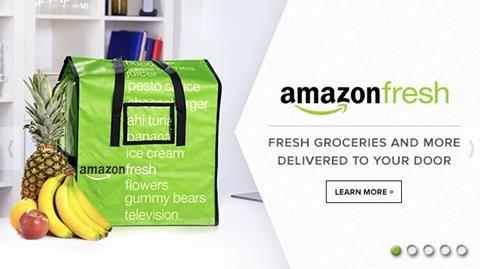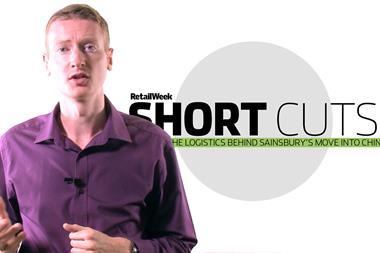Amazon has agreed a 10-year lease on a warehouse in Surrey in the clearest signal yet it is poised to launch into grocery in the UK.

For Amazon, or indeed any overseas retailer targeting Britain’s grocery market, the incentives are massive. According to analysts IGD, the sector is worth £149bn, with online food sales worth £9.57bn, making it the second largest online grocery market in the world behind China. And UK online food sales are forecast to hit £17.2bn by 2020.
But in a market that is already hotly contested by the big four, the discounters, the upmarket alternatives and the convenience specialists, how much of the pie is left to be gobbled up by the global ecommerce giant?
Speculative reports have suggested Amazon Fresh would initially target a 2% slice of the grocery market, a similar share to that currently held by Iceland and three times that of the UK’s biggest online-only grocer, Ocado.
‘Accelerant’ for Prime
Kantar Retail vice-president of retail insights Steve Mader says Amazon would target a specific type of customer, rather than a market share figure, if it brought Fresh to the these shores.
He said the service would be an “accelerant” for its Amazon Prime scheme, just as it is in the US where the majority of Amazon Fresh customers were already Prime shoppers before the grocery service was introduced.
“It’s not a service that people who are not loyal Amazon shoppers utilise,” Mader explains, adding that Amazon will “go after” areas such as London where it has a high density of Prime users.
“There will be some cannibalisation and we think Ocado is probably the most exposed”
Steve Mader, Kantar Retail
“Central London is very well served by four or five of the major grocers already, but is it saturated? Probably not,” Mader says. “There’s still some space to move into, particularly if Amazon can attract its loyal Prime shoppers.
“There will be some cannibalisation though and we think Ocado is probably the most exposed. The saving grace for them is the very good customer satisfaction they have in terms of on-time deliveries and its top-notch customer service.
“It also has a very good private-label proposition, which is something Amazon doesn’t currently have a robust range in.
“But if they begin to lose share of spend from their most highly-populated market, which is London, then it will put profit pressures on them.”
He says that Tesco has a dominant share in central London but will be somewhat protected by its loyalty card.
“When you ask shoppers ‘what’s the primary reason you shop with Tesco as opposed to the other online grocers?’ they say it’s because they use the Tesco Clubcard. But we would still expect some share bleeds from all the major grocers, particularly if Amazon Prime members start switching across,” Mader says.
Hurdles on the horizon
With existing Prime shoppers expected to constitute the core customerbase for Amazon Fresh, Mader believes the etailer will have to jump hurdles in any bid to attract new customers.
He believes Amazon will face an “uphill battle” to maintain its price image when competing with the “buying power and scale” of the big four and says it would have to find ways to differentiate itself from UK competitors.
Mader says: “In the US, people very much like the prospect of having that one-hour delivery window because that’s not something most shoppers have, whereas in the UK we have become somewhat accustomed to that over the past decade or so.
“Everyone is constantly tweaking their fulfilment model and as we’ve seen with Prime Now, Amazon is willing to charge for that extra convenience. The big question we have is: if it was to launch in the UK, what would that membership look like?”
In the US, Amazon charges $99 (£63.56) for an annual Prime subscription, with an additional $200 (£128.40) per year billed to Amazon Fresh customers – something that would prove a deterrent for many British consumers.
Intriguingly though, Amazon has been piloting a system in California that “mimics” the UK model, according to Mader. In the Golden State, Amazon Fresh has shelved the $200 annual subscription cost, instead charging a $7.99 (£5.13) delivery fee per order, bringing it “in line” with its potential British supermarket competitors.
Warning for UK retailers
With that prospect seemingly looming ever larger, Mader issued stark words of caution to all UK retailers, not just the grocers, as Amazon plots the next move in its British invasion.
“Any retailer that competes in a market where Amazon is aggressively investing should be worried”
Steve Mader, Kantar Retail
“Any retailer that competes in a market where Amazon is aggressively investing should be worried,” Mader warns.
“Amazon can quickly launch new fulfilment models and new content delivery vehicles very easily. Every retailer, regardless of what category they are operating in, needs to look at Amazon to see what they are doing, see how shoppers are reacting and see how shoppers’ expectations around convenient delivery and price transparency are being impacted.
“If I was any retailer in the UK, I’d be worried about what Amazon is doing or what it potentially could be doing. But who knows what will happen?”
With Amazon poised to move into its new warehouse next month, retailers won’t have to wait too long to get the answer to that burning question.


























No comments yet